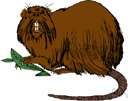There are also families remarkable by unusual adaptation for fossorial life underground (
Spalacidae) showing various unique features.
Rodentia II: Cricetinae, Muridae, Spalacidae, Calomyscidae, Capromyidae, Hystricidae, Castoridae, Koper, 2009.
Ccolak, "Contributions to the karyology and distribution areas of cytotypes of Nannospalax leucodon (Rodentia: Spalacidae) in Western Anatolia," Acta Zoologica Bulgarica, vol.
Fossorial rodents are represented in the cold deserts of South America by the tuco-tuco (Ctenomys, family Ctenomyidae); in North America by the pocket gophers (Geomyidae); and in the cold Asiatic deserts and subdeserts by the mole-voles (Ellobius, family Cricetidae **) and the mole-rat (Spalax giganteus, family Spalacidae **).
** Some authors consider the families Cricetidae and Spalacidae to be subfamilies of the family Muridae.
The blind mole rats, Spalacinae are currently classified within the rodent family
Spalacidae, which includes also zokors (Myospalacinae), bamboo rats (Rhizomyinae) and African mole rats (Tachyoryctinae) (Musser & Carleton 2005).
The vertebral formula was reported as [C.sub.7], [T.sub.13], [L.sub.6], [S.sub.4], [Ca.sub.5] in mole-rats [8]; [C.sub.7], [T.sub.13], [L.sub.6], [S.sub.4], [Ca.sub.6] in the
Spalacidae family [19].
2011a: Variation in C-heterochromatin and NORs distribution among chromosomal races of mole rats (Spalacidae) from Central Anatolia, Turkey.
2013: The chromosome banding pattern in two cytotypes (2n = 36 and 38) of blind mole rats from Turkey (Mammalia: Spalacidae).
For our phylogenetic analyses, we used sequences from the
Spalacidae (Muroidea) as the appropriate outgroup; these were also obtained from GenBank (Table 1).
2008: Karyotype and hair scale structure of Nannospalax leucodon (Nordmann, 1840) from Central Anatolia (Rodentia:
Spalacidae).
Electrophoresis, Genetic differentiation, Nannospalax ehrenbergi, Protein variation,
Spalacidae.
 Spalacidae - mole rats
Spalacidae - mole rats